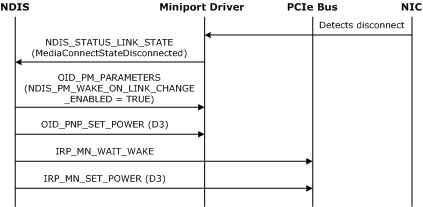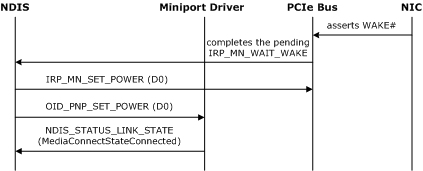Low Power on Media Disconnect
The low power on media disconnect (D3 on disconnect) feature saves power by placing a network adapter in a low-power state (D3) when the media is disconnected. When the media is reconnected, the network adapter is brought back up to the full-power state (D0).
NDIS uses the D3 on disconnect feature under these conditions:
The network adapter hardware must be able to generate a wake event on media connect.
The miniport driver must report the wake event capability of the network adapter in the MinLinkChangeWakeUp member of the NDIS_PM_CAPABILITIES structure.
The value of MinLinkChangeWakeUp must correspond to the value of the DeviceWake member of the DEVICE_CAPABILITIES structure that is reported by the IRP_MN_QUERY_CAPABILITIES IRP.
The miniport driver must register as an NDIS 6.20 driver or later version.
The network adapter must be an Ethernet PCI adapter.
The wake event capability must be enabled by the *DeviceSleepOnDisconnect standard INF file keyword.
The computer chipset must be able to correctly propagate the wake event while the computer is fully powered. NDIS validates this by querying the DEVPKEY_PciDevice_S0WakeupSupported PCI property.
Note that D3 on disconnect is only available while the computer is fully powered in the working state (S0). This feature is canceled when the computer enters a sleep state to prevent waking the computer when the link state is externally cycled; that is, when a switch is turned off and on. For more information about the setting the low-power state when a computer enters a sleep state, see Low Power for Wake on LAN.
A miniport driver reports D3 on disconnect capabilities during initialization. For more information about reporting D3 on disconnect capabilities, see Reporting Power Management Capabilities.
The *DeviceSleepOnDisconnect standard INF file keyword specifies whether the device has enabled or disabled support for D3 on disconnect. For more information about this INF keyword, see Standardized INF Keywords for Power Management.
During initialization, a miniport drivers that supports D3 on disconnect must report the lowest power level where it can support the ability to notify the operating system of media connect event. The miniport driver reports the power level in the MinLinkChangeWakeUp member of the NDIS_PM_CAPABILITIES structure. For example, the miniport driver can report NdisDeviceStateD3.
The following figure illustrates the sequence of events to set a network adapter to a low-power state after a media disconnect event.

When the adapter detects a media disconnect, the following sequence occurs:
The network adapter hardware detects a media disconnect event and passes the information to the miniport driver.
The miniport driver notifies NDIS of a media disconnect event using the NDIS_STATUS_LINK_STATE status indication. The StatusBuffer member of the NDIS_STATUS_INDICATION structure contains an NDIS_LINK_STATE structure. The MediaConnectStateDisconnected value is set in the MediaConnectState member of the NDIS_LINK_STATE structure.
NDIS uses OID_PM_PARAMETERS to disable Wake-on-LAN and to enable wake on media connect (NDIS_PM_WAKE_ON_LINK_CHANGE_ENABLED is set in the WakeUpFlags member).
NDIS uses the OID_PNP_SET_POWER OID to notify the miniport driver of the new power state (D3).
NDIS sends the PCIe bus an IRP_MN_WAIT_WAKE IRP to wait for a reconnect event.
NDIS sets the PCIe bus to the D3 state with the IRP_MN_SET_POWER IRP.
The following figure illustrates the sequence of events to restore full power to a network adapter after a media connect event.

When the media is reconnected the following sequence occurs:
The network adapter wakes the system by asserting WAKE# on the PCIe bus or PME# on the PCI bus.
The bus completes the pending IRP_MN_WAIT_WAKE IRP. The IRP is pending completion from the last step in the disconnect sequence.
NDIS sets the bus to full power (D0) with the IRP_MN_SET_POWER IRP.
NDIS notifies the miniport driver that the network adapter is in the full power (D0) state with the OID set request of OID_PNP_SET_POWER.
The network adapter notifies NDIS of a media connect event with the NDIS_STATUS_LINK_STATE status indication. The MediaConnectStateConnected value is set in the MediaConnectState member of the NDIS_LINK_STATE structure.
Starting with NDIS 6.30, if the miniport driver supports NDIS_STATUS_PM_WAKE_REASON status indications, it must issue this status notification if the network adapter wakes the system. The driver issues this status notification while it is handling the OID set request of OID_PNP_SET_POWER for the transition to a full-power (D0) state.
For more information, see NDIS Wake Reason Status Indications.
Note If the miniport driver issues an NDIS_STATUS_PM_WAKE_REASON status indication, it must do this before it issues the NDIS_STATUS_LINK_STATE status indication.
Feedback
Coming soon: Throughout 2024 we will be phasing out GitHub Issues as the feedback mechanism for content and replacing it with a new feedback system. For more information see: https://aka.ms/ContentUserFeedback.
Submit and view feedback for